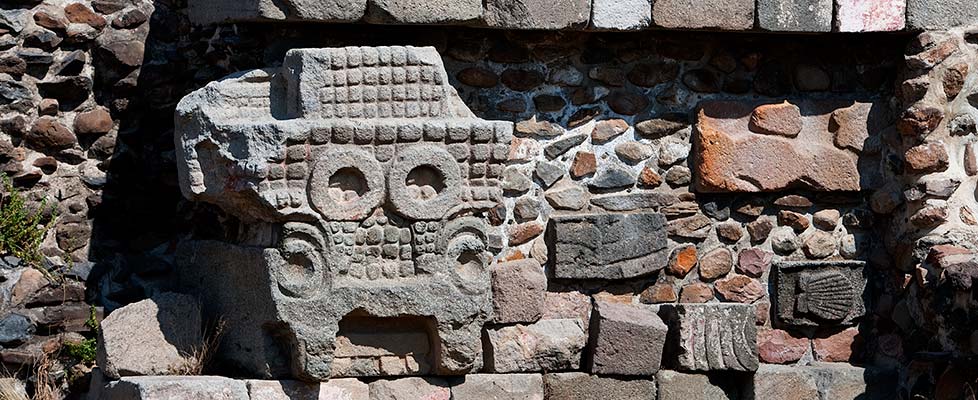EXCLUSIVE CITY OF ANCIENT GODS AND HOLY SHRINES
A historical experience back in time to the ancient holy city of Teotihuacán which translated means ?The City where Gods are born?. After a guided walk through the archeological area of this sacred citadel, including the Pyramids of the Sun and Moon, you will have the opportunity to enjoy local...
EXCLUSIVE CITY OF ANCIENT GODS AND HOLY SHRINES
A historical experience back in time to the ancient holy city of Teotihuacán which translated means “The City where Gods are born”. After a guided walk through the archeological area of this sacred citadel, including the Pyramids of the Sun and Moon, you will have the opportunity to enjoy local delights at the Gran Teocalli restaurant, you before you go on your afternoon visit the Basilica of Guadalupe, the most holy Catholic shrine is the Americas.
More than a 1000 years before the Aztecs became the dominant culture in the central region of Mexico, the ancient city of Teotihuacan was already in the height of its glory. It was, at the time, one of the biggest cities in the world as you will find out on this luxury private visit to witness the archaeological remains of their once colorfully painted great pyramids and wide avenues.
The trip from you hotel with your private guide will take you 50 km northeast of the city before you take a gigantic step back in time to the ancient times of one of the first great Mesoamerican civilizations and their great holy city of Teotihuacan. By the time the Aztecs were in power, the city had long been in decay, abandoned since the 7th century. The original names and purpose of each monument were lost and the names by which they are now known have largely come from the Aztecs who were in awe of the sacred city and gave it the name by which it is known today.
Teotihuacán, meaning “The City where Gods are born”, was declared a UNESCO World Heritage site in 1987, thanks to its colossal architecture and the cultural and artistic influence it had over region. It is one of the most majestic and impressive ancient cities of pre-Hispanic Mesoamerica. The first monuments you will notice are likely to be the massive Pyramid of the Sun (the second biggest pyramid of Mesoamerica) and the Pyramid of the Moon. Both are stepped and steep pyramids which you will need to exercise care to climb on. Notice the huge stone serpent heads, ancient murals and staircases, all vestiges of a splendor that reached its apex between the third and fourth centuries.
The Pyramid of the Sun was built in honor of the god Huitzilopochtli, the God of War, whereas the Pyramid of the Moon is dedicated to the goddess Chalchiuhtlicue (Goddess of Flowing Water). Between them is the Avenue of the Dead, a processional avenue 40 m wide and 2 km long. There are also several ancient Temples carved with mythological creatures adorning the area.
You will then have a taste of the local Mexican and pre-Hispanic cuisine at the Gran Teocalli restaurant nearby to the ancient site with a lunch buffet in lovely surroundings where you can recharge your energy before continuing on with your experience, next to another holy shrine but now of the Hispanic period.
Heading to Mexico´s utmost religious center which welcomes approximately 20 million visitors a year, you will find the Basilica of our Lady of Guadalupe. This is the second most visited Catholic shrine around the world, after Saint Peter’s Basilica within Vatican City. This shrine is located on the Tepeyac hill, where it is said that ten years after the arrival of the Spanish conquistadors in Mexico, in 1531, an apparition of the Virgin of Guadalupe appeared to Juan Diego, a Mexican native who became the first indigenous American saint.
The miraculous sign to prove the authenticity of Juan Diego’s vision was an imprint of an icon of Mary that appeared on his apron when the roses he had gathered (and which had sprung miraculously out from the winter ground when the Virgin appeared to him a second time) fell off the apron when he presented them to a bishop. The icon on the apron, which is displayed at the Basilica, has olive skin, unlike most images of Mary is olive, identifying with the indigenous people in this continent. The importance of this vision of Mary cannot be overstated. Our Lady of Guadalupe is the patron saint of Mexico as well as the rest of the Americas.
The original Basilica, which dates back to the early 16th century, is still there but mass and visits are not at the new and much bigger Basilica next door completed in 1976 by the Mexican architect Pedro Ramirez Vasquez.



